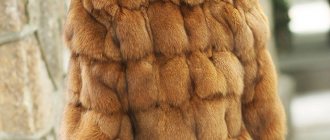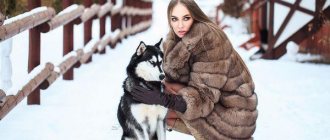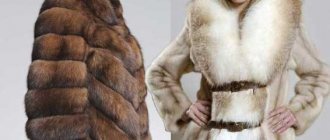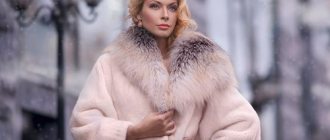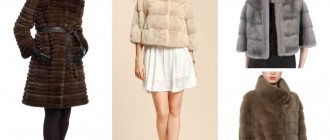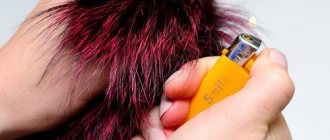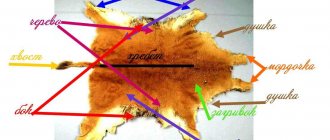Fur products have always been considered luxury items, but at the same time, in our climate they are necessary. In ancient times, they were valued even higher than now, because there were no artificial materials that could replace warm fur clothing.
In ancient times, animal skins were often used not only for making clothes - they were the equivalent of modern money.
However, not all furs are the same in price. The difference is due to the appearance of the fur, its shine and beauty, and its properties, such as wear resistance. What is the most expensive fur in the world? We have compiled a rating of the most expensive furs - of course, they are all very beautiful and practical.
How much does the most expensive fur coat in the world cost and whose fur is it made from?
Fur coat for a million euros
The most expensive fur coat in the world was created based on the idea of the famous German fashion designer and creative director of the fashion brand Fendi, Karl Lagerfeld. This product, which amazed all fashion connoisseurs with its beauty, was made of sable fur. The fur coat required 36 high-quality sable skins. Today, the product, called “Moonlight on water,” is valued at one million euros.
What is the value of this unique designer item? Dark sable fur and a large number of skins are not all the factors that influenced its cost. To create the fur coat, a special fur processing technology was used. It is coated with a special coating that gives the product a beautiful metallic shine. It is this feature that makes the fur coat unique and incredibly expensive.
Content:
- Fur products in the old days: historical information from different countries
- Why is a vicuna fur coat so highly valued?
- Magnificent marten
- The most delicate chinchilla coats: the history of their popularity
- Soft gold: high-grade sable fur
- The property of the Russian Monetary Fund is the fluffy ermine
- Exclusive lynx wardrobe items
- Why modern fashionistas choose mink
- Practical long-haired Arctic fox
- Video
Our article is devoted to the luxurious and warm material from which clothes have been made since primitive times. Of course, we will talk about fur - namely, about its expensive and exclusive types that will never go out of fashion.
The word fur coat itself is borrowed from the Arabic language, where it sounds like “jubba”. True, the Arabs call woolen wardrobe items trimmed with natural fur this way. Perhaps because in the hot eastern climate, whole fur coats are not at all as relevant as in our northern latitudes.
Since ancient times, natural fur has been considered not only a raw material for sewing warm clothes, but also a valuable monetary unit, as well as an opportunity to emphasize one’s privileged social position and financial well-being. Noble people of Ancient China wore fur coats made of fox and sable, over which they threw elegant silk robes. The Vikings traded the skins of fur-bearing animals for various valuable goods.
Representatives of the elite classes of Baghdad and Byzantium gave gold, silver and other treasures for furs, caravans with which followed along the Silk Road.
In Europe, the most popular was a voluminous and long fur coat with flared sleeves - the so-called tappert. Such clothing was not very comfortable for everyday wear - and over time, tailors shortened it to the semblance of a modern bat-style fur jacket.
On the territory of Ancient Rus', fur products were in demand even more widely than in other states. The harsh climate of our country did not allow wearing clothes with fish fur, so wardrobe items made of sable, marten and ermine were highly valued.
Predatory cat
Lynx fur also varies. As we have already mentioned, it even matters from which part of the body the skin is taken. The belly of the lynx is used to decorate the most prominent elements of a fur product - collar, front, chest. And the wool from the sides and back is used for finishing elements, such as fur coat cuffs, a belt, and a hood. The fur of the common lynx is considered the most valuable. Often wild cat skins are combined with other materials, complementing the product with leather or suede and even woolen fabric.
Beaver – tenth place
The fur of a beaver is called beaver. The skin of this animal is highly valued, and all because it is distinguished by its beauty and high strength. The fur is shiny, silky, and somewhat rough to the touch, however, it is very dense due to the presence of a rich undercoat that does not allow moisture to pass through.
Beaver clothing, although it is not the most expensive fur coat in the world, costs up to 70,000 rubles. The color of the finished product varies from dark red to almost black, the iridescence of the shade is very beautiful. The service life of a fur coat reaches twenty years, it does not lose its quality and appearance even after being exposed to rain, and is also very popular among ladies.
As a rule, natural skins are used to make men's fur coats, and plucked beaver is used to make women's clothing.
Mink
Mink fur today is the most popular among fur manufacturers. Most consumers consider mink coats to be the ideal combination of price and quality.
The fashion for mink fur was introduced by Hollywood celebrities back in the 1930s. Mink wool is silky, soft, thick down and has long guard hairs. Today, various experiments are carried out on mink fur: the pile is dyed in different colors, cut, bleached, laser-treated, perforated, and combined with other materials.
Mink coats have the following qualities:
- ease;
- practicality;
- wear resistance (average 10 years);
- attractive appearance for a long time.
The leading positions in the volume of mink skins procurement are occupied by North America and the Scandinavian countries. Manufacturers offer a choice of mink in different tones and halftones. The fur coat is of high quality, and its owner looks stylish and elegant.
A mink coat, depending on the color and processing technique, will cost $4,000-$15,000.
Arctic fox
The arctic fox, like the silver fox, was used as fur in ancient Rus'. The animal in the wild comes in two colors: blue and white. The nobility of the colors makes arctic fox fur popular among wealthy people; Hollywood stars love to wear products made from it.
An animal with a blue color is much less common than a white one, and therefore costs accordingly. Arctic fox blue, which fashion designers call the color of cloudy skies, can have different saturations. Light blue fur has a thick pile with a white base and blue tips, so it seems that there is a bluish veil on the skin.
Arctic fox fur is long-haired. Products made from this material are fluffy, warm and comfortable to wear. An arctic fox fur coat will last quite a long time - on average 7 years.
Designer fur coats made from Arctic fox can cost from $2,000 to $6,000.
Fashionable items
Classic never goes out of style. She is timeless. Modern trends only slightly adjust fur coats of a classic cut: a variety of decor, inserts, and accessories appear.
The combination of styles looks very impressive. A simple, laconic white fur coat with a frill collar that forms beautiful folds and comes from the past looks amazing. It strangely alternates simplicity and luxury, which coexist perfectly in one product.
Fashionable new items this season are distinguished by the contrast of fur inserts in both color and texture. These models look quite unusual, but that’s their beauty. At the same time, inserts can form interesting geometric shapes.
The glamor style is not losing ground. The glamorous fur coat has a straight cut, bright colors, and straight sleeves.
The current length of the models is up to the middle of the shin or just below the knee. As for volume, the longer the fur coat, the less voluminous it should be. This point should definitely be taken into account when choosing a product.
Chinchilla
Chinchilla fur is recognized throughout the world as a thick, silky and lightweight material. This fur-bearing animal is native to South America and is highly prized for its incredible density of fur. Each hair follicle of a chinchilla skin grows 60-80 hairs. No other fur-bearing animal can boast of this.
Due to the incredible thickness of the fur, the chinchilla’s body is free from parasites that are typical of rodents. The animal's hair is nothing more than elastic and delicate fluff, which reaches a thickness of 3 cm. The color scheme consists of beautiful shades: rich gray wool on the back, turning into bluish-smoky fluff on the sides and snow-white hair on the sides. abdomen.
The density of the animal’s fur coat and its color contributed to the high cost of fur products, which began to be used by representatives of the ancient Indian civilization. At that time, only respected persons could dress in fur.
Today, chinchilla fur coats are sold all over the world, and their cost depends on the quality of the material, its color, exclusivity and style of the product. At the same time, you need to be aware of the fact that one product can take up to 170 animal skins, and it will not last long - up to 3 winters. Chinchilla fur coats are usually bought not for everyday wear, but “for going out.”
You can buy a chinchilla fur coat for $20,000-200,000.
Chernoburka – ninth place
Another most expensive fur coat in the world is the silver fox skin. The fur of a black-brown fox looks truly luxurious, it has a silky, long pile. The material is great for making fur coats for young girls, as well as elegant older ladies.
The peculiarity of this fur is that it goes well with other materials, for example, with leather or knitwear, which modern fashion designers use with might and main. Quite often, black-brown fox skins are used shorn or plucked, which makes the appearance of the finished products more extravagant.
Black and brown foxes are raised in special nurseries, and therefore there are quite a lot of products made from such fur on the market. The approximate cost of a finished fur coat is up to one hundred thousand rubles.
Ermine
Ermine has elegant fur, which has been used for many centuries to create wardrobe items for royal families and high government officials. Due to the softness of the skin and snow-white color, velvety and density, ermine fur is considered an elite material.
A special feature of the ermine is the change in coat color depending on its habitat and heredity. It can be either snow-white or darker shades. In winter, white fur can only be seen on animals that live in areas with a harsh cold climate. Such stoats are found in Lapland, Canada and Siberia.
Among the disadvantages of ermine fur, one can note its low wear resistance (the service life of the product rarely exceeds 4 years).
The cost of an ermine fur coat ranges from $3,000 to $5,000. The most expensive item made of ermine fur - Marilyn Monroe's snow-white stole - was sold at auction for $69,000.
Rating of the most expensive furs
The cost of a fur coat depends primarily on the type of fur from which it is made. The price is influenced by the appearance and performance characteristics: color, thickness and shine of the wool, as well as resistance to abrasion and creasing. Products made from the skins of rare animals that are not bred on special farms are much more expensive.
10th place − Black-brown fox
The fur of the steppe animal is distinguished by soft silky pile, reaching 7-8 cm in length and a thick undercoat. The silver fox is deservedly called the “queen” among furs due to the optimal combination of original colors and excellent performance characteristics.
Due to the uneven color of the hairs (from light gray to smoky at the base, white in the middle and black at the tip), the finished product acquires recognizable beautiful color transitions.
Breeders from the best fox farms in Norway and Finland are breeding mutational colored animals. The number of skins received with new exclusive colors usually does not exceed 20 pieces. This is a very rare and expensive product that is sold only at fur auctions.
A fur coat made from this type of fur is light and retains heat well, so even at a temperature of -25° C it will be comfortable. High air humidity and gusty winds will not spoil the appearance of the product. Due to the long pile and thick undercoat, creases practically do not form on a silver fox fur coat, so its wear life can be up to 10-15 seasons.
Fox fur looks advantageous in combination with other materials - leather, fabric, wool. Many fashion houses use painted silver fox in their collections. It is used to make hats, muffs, and is also used as a trim for collars and other clothing items.
The price of a fur coat starts from 80,000 to 100,000 rubles. Specimens from foxes with rare colors can be much more expensive.
9th place - Ermine
The fur of this small predatory animal of the mustelid family is rightly called royal. It has long been used to decorate the robes of rulers and high nobility. The image of the animal can be found on the coats of arms of the Dukes of Brittany.
Snow-white ermine fur, decorated with black tails, was considered a symbol of power, moral and intellectual purity. Clothes trimmed with this fur indicated that the wearer belonged to a royal family.
The reason for the special attitude towards the animal was an ancient legend. According to it, the Duke of Brittany, fleeing persecution by enemies, encountered an unexpected obstacle in the form of a river with muddy banks. Not far away, he noticed an ermine, which was running away from the horses and also suddenly froze in front of the pond. At the very shore, the animal suddenly turned back - it preferred to die than to stain its snow-white coat with mud. Duke Alan Barbetort was amazed by the courage of the predator and, with the exclamation “Better death than shame,” turned to the enemy.
Ermine fur is unusually soft and pleasant to the touch. The length of the pile does not exceed 2 cm. It is distinguished by its shine and thickness, but in terms of wear resistance it is approximately on the same level as rabbit wool.
The animal acquires a snow-white fur color only in winter to camouflage itself in the snow from predators. Ermine has a thin skin, so fur coats are made from it without insulation. It won't keep you warm in the cold, but it will fit beautifully on your figure, emphasizing its advantages.
It is better to leave this truly royal fur for going out, as from frequent wearing it will quickly lose its attractiveness and will last no longer than two seasons. The price of a short fur coat starts from 100,000 rubles, and a knee-length product can cost an average of 180 thousand.
8th place - Karakul
There are several varieties of sheep fur. For sewing fur coats, mainly mouton (wool processed and trimmed in a certain way), as well as broadtail and astrakhan fur are used.
To produce the latter, the skins of newborn lambs of the Karakul breed, which are no more than three days old, are used. Natural coat colors are black, silver gray and beige. The rare white Afghan karakul is considered especially valuable.
The cost of the skin depends on the beauty of the pattern formed by the wool curls, their type, elasticity and silkiness. Each has a unique pattern. Gray fur with brown hairs is considered one of the most beautiful. They form a unique lilac tint on the finished product.
Another rare and valuable variety of astrakhan fur is sur. Its highlight is the beautiful natural stretch of color. The hairs gradually change the intensity of the shade from rich chocolate at the base to lighter at the ends.
The most expensive karakul is made in Namibia (svakara). The skins of this type of sheepskin are very light and durable, and the curl is elastic and flat.
To produce broadtail, the skins of unborn lambs are used. They are valued much higher due to their shorter, silkier coat and large, poorly formed curls that form a beautiful moire pattern. The high cost of fur coats made from such material is also due to the small size of the skins.
Despite their lower strength compared to astrakhan, they are more popular. The price of a broadtail fur coat ranges from 8 to 10 thousand dollars.
7th place - Arctic fox
The silky and shiny fur of the small predator has long been popular in Rus'. Thanks to the thick down, fur coats made from its skins retain heat well even in severe frosts, and are also highly wear-resistant.
A product made from white fox will not lose its attractive appearance even after nine seasons of wear, and from blue - up to twelve. If necessary, it lends itself well to restoration and painting.
Famous couturiers love to use this type of fur in their collections. It can be dyed or trimmed and combined with other materials to create a unique look.
Arctic fox fur coats gained popularity after famous cinema divas - Marlene Dietrich, Elizabeth Taylor and Marilyn Monroe - began to appear on screen in them.
Undyed fur can be white (an animal's fur only becomes this way in winter) and smoky gray, the color of a cloudy sky. This is a blue fox - another rare breed. It does not shed when cold weather sets in. Blue fox fur is extremely beautiful and very expensive, so it is used mainly for decoration. It can be veiled (with white underfur and blue hairs at the ends) or silver.
The high cost of arctic fox fur coats is also explained by the difficulty of cutting the skins due to the different thickness of the skin, which requires an individual approach to each product. The average price of a white fox fur coat is from 150 thousand rubles.
6th place - Marten
Luxurious and expensive fur, which in appearance resembles sable. You can distinguish it only if you look closely at the undercoat, which is less dense on the marten.
The high cost of skins is explained by the difficulty of breeding animals in captivity and the ban on hunting them, which creates a shortage in conditions of increased demand. Marten fur is soft, shiny, with long fibers. Particularly valuable are skins obtained in winter, when the animal acquires a thick down. This fur coat will last at least 7-8 seasons.
Marten fur comes in a rich palette of shades: from smoky beige to rich chocolate color. The main advantage of such fur coats is hypoallergenicity. Due to the special structure of the villi, dust and other particles do not linger on them. The average price of a marten coat varies from 200,000 rubles to a quarter of a million.
5th place - Mink
A fur coat made of luxurious mink fur is the best value for money. Products made from animal skins have remained at the peak of popularity for decades in a row, and there are several reasons for this. The first is high wear resistance. A mink coat, if worn carefully, will retain its original appearance even after 7-8 years of service. The second reason is that the fur is so fluffy and thick that it retains heat even at -25°, so it will be comfortable in the most severe frosts.
The best furs are produced by US farms, including the Blackglama variety. It is being sold in a limited lot (45 pelts) exclusively at the American Legend fur auction in Seattle. This is the rarest and most expensive type of black mink fur with very fine guard hair and thick underfur. Due to the few inclusions of brown hairs, the finished product acquires beautiful color transitions. The fur is very soft and silky to the touch, and looks like velvet.
The price of a Blackglama mink coat can reach 15-20 thousand dollars.
4th place - Chinchilla
The fur of this fur-bearing animal, originally from South America, has long been used to decorate the clothes of the rulers of ancient Indian civilizations and was considered a symbol of power and might.
It differs from other types of fur in its increased density and density: from one hair follicle grows from 70 to 80 hairs, and there are up to 25 thousand of them per square centimeter of skin.
Thanks to this, wearing a chinchilla fur coat you can not be afraid of the piercing cold wind and twenty-degree frosts. The length of the guard pile is from 2.5 to 3 cm. The fur is silky, soft and elastic to the touch. Chinchilla skins are hypoallergenic and do not have a specific odor.
The color of the animal's fur is uneven and represents a smooth gradient from a dark gray back to smoky blue sides and a snow-white belly. The unique coloring cannot be imitated, and clothes made from such fur look luxurious. The cost of a chinchilla fur coat reaches seven million rubles or more. It is not recommended to wear it every day, since the delicate fur is not particularly resistant to abrasion and deteriorates from high humidity.
3rd place - Lynx
A luxurious fur coat made from the fur of this feline predator is an expensive pleasure that not everyone can afford. The highlight is the original colors, shimmering in all shades of gold and bronze, as well as the unique pattern of spots. The animal's fur resembles a royal robe and attracts the attention of others.
To produce the best fur coats, they use the fur of the Canadian lynx cat, since only Canada has quotas for catching the animal. Fur for sewing elite products is taken only from the abdominal part of the skin. The pile there is the softest and thickest. The side parts are used to trim collars and sleeves.
Due to the high cost of fur, entire fur coats from lynx fur are sewn to order. It is better to wear them in dry, frosty weather, as high humidity spoils valuable fur.
The cost of lynx fur coats ranges from 50 to 250 thousand US dollars.
2nd place - Sobol
One of the most expensive types of fur and a national treasure of Russia. Barguzin fur is considered the rarest. This is an animal of the sable family, lives on the eastern coast of Lake Baikal. Its soft, silky and shiny fur with a bluish tint and black down is valued much higher than other species. A fur coat made from skins interspersed with white fibers will cost even more.
A product made from sable fur will last at least 12 seasons, as the wool is resistant to abrasion and creases.
The price of one skin at a fur auction can reach two thousand dollars, and to sew a long fur coat you will need at least 50-60 pieces. Sable fur is rightly called “soft gold” not only for its high cost, but also for its chic appearance. That is why he was chosen by the former head designer of Chanel and Fendi, Karl Lagerfeld, to create the pearl of his autumn-winter 2015 collection. The most expensive Barguzin sable fur coat from the haute couture maestro was valued at 1 million euros.
1st place - Vicuña
The most expensive fur in the world belongs to the vicuña. This animal is a close relative of the llama and lives exclusively in the highlands of the Andes, in Peru (the largest population), Chile, Ecuador and Bolivia. Vicuna fur is very soft and thin, but at the same time thick and reliably protects from the cold. In terms of density and silkiness, it surpasses even chinchilla.
The vicuña is one of the revered animals in Peru - it is depicted on the country's coat of arms and flag. Its wool was highly valued even during the time of the Incas. The animals were herded into a herd and their fur was cut off, trying not to cause them pain, and then released into the wild. Only rulers and priests had the right to wear clothes made from this fur.
Vicuna fur is practically not used for sewing fur coats, since shooting animals is officially prohibited. Only hair trimming is allowed twice a year. From one individual you can get only 400-500 grams of fleece. Hand-sorted wool costs from 1 thousand dollars per kilogram, and the price of a meter of finished fabric from it reaches 5 thousand.
Buying outerwear made from vicuña fur is not easy due to its high cost and inaccessibility. A wide range of woolen products is presented in the collections of the famous Italian fashion house Loro Piana.
Marten
The appearance of marten fur resembles that of sable, which is somewhat more expensive. The only difference is in the density, which is less in martens. In ancient times, in European countries where sable was not found, it was successfully replaced by marten.
Marten fur has a rich color palette, which varies from grayish-smoky to deep brown. Marten wool has a thick undercoat and a fairly long pile, thanks to which fur coats made from marten skins are worn for a long time - on average about 7 seasons.
Fur that was harvested in winter is especially valuable. During this season it is the longest and thickest. Marten skins are famous for their hypoallergenic properties: the material has a well-ventilated structure in which dust does not accumulate, which is a common cause of allergies.
Practical and high-quality marten fur coats can be purchased for $3000-7000.
Black and brown fox
Silver fox fur was used back in the days of ancient Rus' not only for making royal or princely outfits, but also for various pagan rituals. Thanks to its dark color and luxurious coat, the silver fox contrasted perfectly with pale-skinned aristocrats and ladies who loved bright makeup.
The fur of the black-brown fox is quite thick and long. Its lush pile is ideal for creating winter coats, as it is warm and wear-resistant (average service life is 6 years). Silver fox fur coats can be of several shades, starting with a light color with individual dark fibers and ending with a rich dark gray undercoat with a black admixture.
The higher the degree of silver fox skin, the more expensive it is. The cost of a black-brown fox fur coat varies between $1000-3000.
Simple female happiness
Mink coats belong to the outerwear of the elite segment, but at the same time they are accessible to women with average incomes. Moreover, having bought it once, the owner can wear warm clothing for several years, during which it will retain its original appearance.
Mink fur is beautiful in itself; previously it was rarely subjected to additional processing, but now it is dyed and sheared. It is also one of the few types of fur that can be lightened and modified using a light laser.
Sable
Sable fur is very highly valued, so even in Russia, where this fur-bearing animal is found, not everyone can afford such luxury. Sable skins have long been considered a symbol of luxurious life and an indicator of a person’s social status.
Due to its density, color and quality, sable furs are recognized as the best in the world. They are almost as durable as beaver fur. The color of sable pile is so beautiful by nature that for their creations designers prefer to use skins only in their natural form: they are not dyed or treated with anything.
The most valuable and expensive fur is the Barguzin sable. The habitat of this animal is the eastern shores of Lake Baikal. The variety of shades and unique structure makes this fur a leading position among the furs of other fur-bearing animals.
The most prized is the chocolate-colored skin with down and gray patches. Podpushek has a characteristic bluish tint. This is the type of fur that couturiers around the world prefer to use.
One sable skin costs on average $1,500-2,000. Even for the shortest sable fur coat you will need to pay more than $50,000, and the cost of a sable coat is absolutely amazing - about $250,000. The most expensive Barguzin sable fur coat is considered to be the creation of Karl Lagerfeld for $1 million.
Lynx
Lynx is a rare animal, so its skin is very expensive. A special feature of lynx fur is its uniquely beautiful color. The fur that is most prized is the one obtained from the belly of the lynx. It is soft and white, sometimes decorated with bright black spots.
Fur coats for which only lynx skins were used are quite rare on sale. Typically, this material is used to trim clothes made from other types of fur. The price of such a product depends on the name of the designer and on how much animal skin was used to create it: if it is only the finishing, the clothing will cost less than a full lynx coat. A fur coat made from the backs of a lynx will also cost cheap - in the range of $500-1000.
The price for a high-quality lynx fur coat varies from $50,000 to $250,000.
